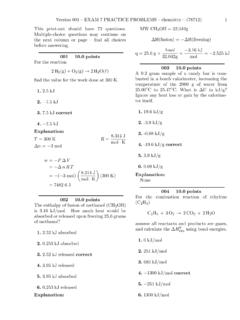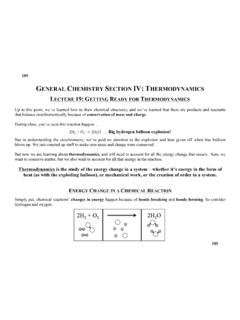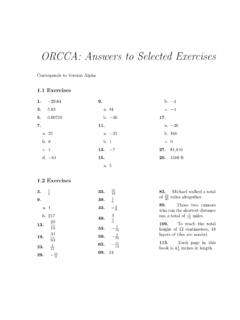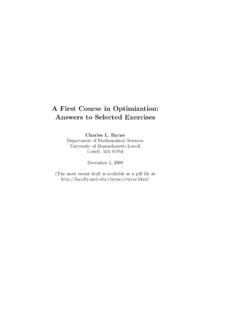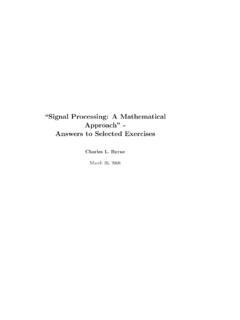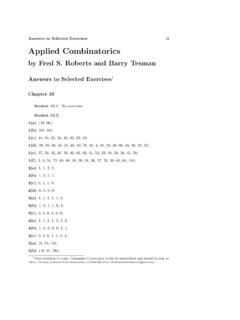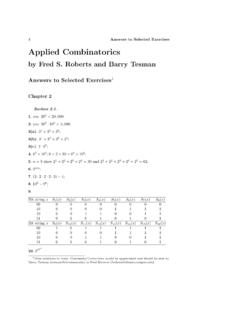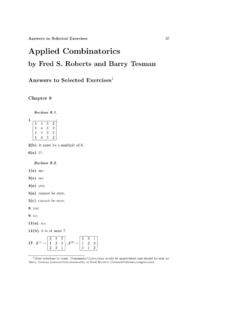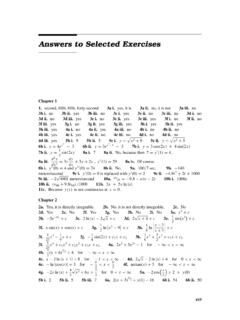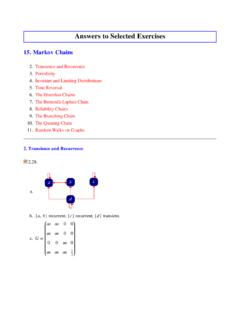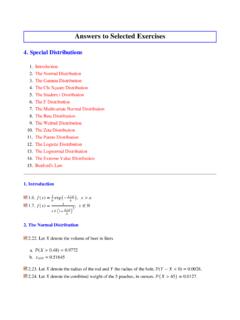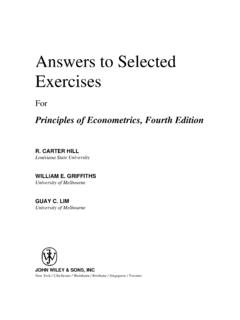Transcription of Answers to Selected Exercises - McCord CH302
1 The Answers listed here are from the Complete Solutions Guide,inwhich rounding is carried out at each intermediate step in a calcu-lation in order to show the correct number of significant figures for that step. Therefore, an answer given here may differ in the lastdigit from the result obtained by carrying extra digits throughoutthe entire calculation and rounding at the end (the procedure youshould follow).Chapter the masses of hydrogen in these three compoundscan be expressed as simple whole-number ratios.
2 The g H/g N inhydrazine, ammonia, and hydrogen azide are in the ratios 6:9 , ; Na, ; Mg, ; O and Mg are incorrect by a factor of 2; correct formulas are H2O, Na2O, and (nucleus) 3 1015g/cm3; d(atom) charges are whole-number multiples of 10 13zirkombs,then the charge on one electron could be 10 , 10 13zirkombs could be the charge of two elec-trons (or three electrons, etc.). All one can conclude is that thecharge of an electron is 10 13zirkombs or an integer frac-tion of 10 the plum pudding model were correct (a diffuse positive charge with electrons scattered throughout), then particles should have traveled through the thin foil with very minor deflections in their path.
3 This was not the case because a fewof the particles were deflected at very large angles. Rutherfordreasoned that the large deflections of these particles could becaused only by a center of concentrated positive charge that con-tains most of the atom s mass (the nuclear model of the atom). atomic number of an element is equal to the number ofprotons in the nucleus of an atom of that element. The mass num-ber is the sum of the number of protons plus neutrons in the nucleus. The atomic mass is the actual mass of a particular isotope(including electrons).
4 As we will see in Chapter 3, the average massof an atom is taken from a measurement made on a large numberof atoms. The average atomic mass value is listed in the The noble gases are He, Ne, Ar, Kr, Xe, and Rn (helium, neon, argon, krypton, xenon, and radon). Radon has only radioactive isotopes. In the periodic table, the whole numberenclosed in parentheses is the mass number of the longest-lived isotope of the element. b. promethium (Pm) and technetium (T c) Five; F, Cl, Br, I, and At; b. Six; Li, Na, K, Rb, Cs, Fr (H isnot considered an alkali metal.)
5 C. 14; Ce, Pr, Nd, Pm, Sm, Eu, Gd,Tb, Dy, Ho, Er, Tm, Yb, and Lu; d. 40; all elements in the blockdefined by Sc, Zn, Uub, and Ac are transition 12 p,12 n, 12 e; b. 12 p, 12 n, 10 e; c. 27 p, 32 n, 25 e; d. 27 p, 32n, 24 e; e. 27 p, 32 n, 27 e; f. 34 p, 45 n, 34 e; g. 34 p, 45 n,36 e; h. 28 p, 35 n, 28 e; i. 28 p, 31 n, 26 ;11850Sn2 Lose 2 e to form Ra2 ; b. Lose 3 e to formIn3 ; c. Gain 3 e to form P3 ; d. Gain 2 e to form Te2 ; e. Gain1 e to form Br ; f. Lose 1 e to form Rb , aluminumchloride; CrCl3, chromium(III) chloride; ICl3, iodine trichloride;AlCl3and CrCl3are ionic compounds following the rules for nam-ing ionic compounds.
6 The major difference is that CrCl3contains atransition metal (Cr) that generally exhibits two or more stablecharges when in ionic compounds. We need to indicate whichcharged ion we have in the compound. This is generally true when-ever the metal in the ionic compound is a transition metal. ICl3ismade from only nonmetals and is a covalent compound. Predictingformulas for covalent compounds is extremely difficult. Because ofthis, we need to indicate the number of each nonmetal in the binarycovalent compound. The exception is when there is only one of thefirst species present in the formula; when this is the case, mono-is not used (it is assumed).
7 Sulfur difluoride; b. dinitrogentetroxide; c. iodine trichloride; d. tetraphosphorus copper(I) iodide; b. copper(II) iodide; c. cobalt(II) iodide;d. sodium carbonate; e. sodium hydrogen carbonate or sodium bicarbonate; f. tetrasulfur tetranitride; g. sulfur hexafluoride;h. sodium hypochlorite; i. barium chromate; j. ammonium SO2; ; ; d. KHSO3; ; f. Cr2(CO3)3;g. Cr(C2H3O2)2; h. SnF4; (composed of NH4 andHSO4 ions); j. (NH4)2 HPO4; k. KClO4; l. NaH; m. HBrO;n. lead(II) acetate; b.
8 Copper(II) sulfate; c. calciumoxide; d. magnesium sulfate; hydroxide; f. calciumsulfate; g. dinitrogen monoxide or nitrous oxide (common) nitric acid, HNO3; b. perchloric acid, HClO4; c. acetic acid,HC2H3O2; d. sulfuric acid, H2SO4; e. phosphoric acid, g S; 230. g True; b. False. The isotope has 34protons; c. False. The isotope has 45 neutrons; d. False. The iden-tity is selenium, ; 142 : selenate; SeO32 :selenite; TeO42 : tellurate; TeO32 : , atomic massof In ; In2O3, atomic mass of In ; antimony(III) ; 18 The com-pounds have the same number and types of atoms (same formula), but the atoms in the molecules are bonded together differently.
9 Therefore, the two compounds are different compoundswith different properties. The compounds are called isomers of eachother. b. When wood burns, most of the solid material in wood isconverted to gases, which escape. The gases produced are mostlikely CO2and H2O. c. The atom is not an indivisible particle, butis instead composed of other smaller particles electrons, neutrons,and protons. d. The two hydride samples contain different isotopesof either hydrogen or lithium. Although the compounds are com-posed of different isotopes, their properties are similar because different isotopes of the same element have similar properties (except, of course, their mass).
10 Ratio of the masses of R that combine with g Q is 3 1, as expected by the law ofmultiple proportions. :H ratio 8:18 or 4:9 Chapter amu; are three peaks in themass spectrum, each two mass units apart. This is consistent withtwo isotopes, differing in mass by two mass units. The peak corresponds to a Br2molecule composed of two atoms ofthe lighter isotope. This isotope has mass equal to 2 , which corresponds to 79Br. The second isotope is 81Br withmass equal to 2 The peaks in the mass spectrumA41 Answers to Selected ExercisesA42 Answers to Selected Exercisescorrespond to 79Br2, 79Br81Br, and 81Br2, in order of increasingmass.
